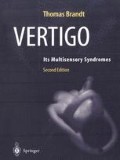Abstract
Transient positional nystagmus has been repeatedly observed following the ingestion of water- and lipid-soluble molecules with specific gravities differing from that of endolymph, such as alcohol or “heavy water”. The semicircular canals selectively transduce angular velocity and head acceleration, and under normal circumstances are insensitive to gravitational orientation and linear acceleration. A major reason for this insensitivity to head orientation in space is that the cupula and endolymph have the same specific gravity of 1.0087 relative to water (the sensory hair cells are embedded in the cupula which is housed in the ampulla of the canals). The neutral buoyancy of the cupula in the endolymph prevents any out-of-balance forces when linear accelerations are applied.
Access this chapter
Tax calculation will be finalised at checkout
Purchases are for personal use only
Preview
Unable to display preview. Download preview PDF.
References
Afifi AM, Tawfeek S (1971) Deafness due to Waldenströms macroglobulinemia. J Laryngol Otol 85: 275
Andrews JC, Hoover LA, Lee RS, Honrubia V (1988) Vertigo in the hyperviscosity syndrome. Otolaryngol Head Neck Surg 98: 144–149
Angelborg C, Klockhoff I, Stahle J (1971) The caloric response in Menière’s disease during spontaneous and glycerol-induced changes of the hearing loss. Acta Otolaryngol (Stockh) 71: 462–468
Aschan G (1958) Different types of alcohol nystagmus. Acta Otolaryngol (Stockh) 140: 69–78
Aschan G, Bergstedt M, Goldberg L, Laurell L (1956) Positional nystagmus in man during and after alcohol intoxication. J Stud Alcohol 17: 381–405
Barâny R (1911) Experimentelle Alkoholintoxikation. Monatsschr Ohrenheilkd 45: 959–962
Bolch KJ, Maki DG (1973) Hyperviscosity syndrome associated with immunoglobulin abnormalities. Semin Hematol 10: 113–124
Brandt Th (1990) Positional and positioning vertigo and nystagmus. J Neurol Sci 95: 3–28
Brandt Th, Daroff RB (1980) The multisensory physiological and pathological vertigo syndromes. Ann Neurol 7:195–203
DeKleyn A, Versteegh C (1930) Untersuchungen über den sogenannten Lagenystagmus während akuter Alkoholvergiftung beim Kaninchen. Acta Otolaryngol (Stockh) 14: 356–377
Fahey JL, Barth WF, Solomon A (1965) Serum hyperviscosity syndrome. JAMA 192: 464–467
Fetter M, Haslwanter T, Bork M, Dichgans J (1999) New insights into positional alcohol nystagmus using 3-D eye movement analysis. Ann Neurol In press
Goldberg L, Störtebecker TP (1941) Criteria of alcohol intoxication in animals in relation to blood alcohol. Acta Physiol Scand 3: 71–81
Harris CS, Guedry FE, Graybiel A (1962) Positional alcohol nystagmus in relation to labyrinthine function. NSAM 839, NASA R-47, Naval School of Aviation Medicine, Pensacola
Ito M, Watanabe Y, Shojaku H, Kobayashi H, Aso S, Mizukoshi K (1993) Furosemide VOR test for the detection of endolymphatic hydrops. Acta Otolaryngol (Stockh) Suppl 504: 55–57
Jones AW, Neri A (1994) Age-related differences in the effects of ethanol on performance and behavior in healthy men. Alcohol Alcoholism 29: 171–179
Keim RJ, Sachs GB (1975) Positional nystagmus in association with macroglobulinemia. Ann Otol 84: 223–227
Koizuka I, Takeda N, Kubo T, Matsunaga T, Cha CI (1989) Effects of ethyl-alcohol and heavy water administration on vestibuloocular reflex in rabbits. ORL 51: 151–155
Kubo T, Sakata Y, Koshimune A, Sakai S, Ameno K, Ijiri I (1990) Positional nystagmus and body sway after alcohol ingestion. Am J Otolaryngol 11: 416–419
Ledin T, Ödkvist LM (1991) Effect of alcohol measured by dynamic posturography. Acta Otolaryngol (Stockh) Suppl 481: 576–581
Logothetis J, Silverstein P, Coe J (1960) Neurological aspects of Waldenström’s macroglobulinemia. Arch Neurol 3: 564–573
Money KE, Myles WS (1974) Heavy water nystagmus and effects of alcohol. Nature 247: 404–405
Money KE, Johnson WH, Cerlett BMA (1965) Role of semicircular canals in positional alcohol nystagmus. Am J Physiol 208: 1065–1070
Money KE, Myles WS, Hoffert BM (1974) The mechanism of positional alcohol nystagmus. Can J Otolaryngol 3: 302–313
Nito Y, Johnson WH, Money KE, Ireland PE (1964) The nonauditory labyrinth and positional alcohol nystagmus. Acta Otolaryngol (Stockh) 58: 65
Rietz R, Troia BW, Yonkers AJ, Norris TW (1987) Glycerol-induced positional nystagmus in human beings. Otolaryngol Head Neck Surg 97: 282–287
Ronis ML, Rojer CL, Ronis BJ (1966) Otologic manifestations of Waldenström’s macroglobulinemia. Laryngoscope 76: 513–523
Rothfeld J (1913) Über den Einfluß akuter und chronischer Alkoholvergiftung auf die Funktion des Vestibularapparates. Monatsschr Ohrenheilkd 47: 1392–1393
Ruben RJ, Distenfeld A, Berg P, Carr R (1969) Sudden sequential deafness as the presenting symptom of macroglobulinemia. JAMA 209: 1364–1365
Schuknecht H (1969) Cupulolithiasis. Arch Otolaryngol 90: 765–778
Takeda T, Takeuchi S, Saito H (1990) Effect of glycerol on pressure difference between perilymph and endolymph. Acta Otolaryngol (Stockh) 110: 68–72
Takumida M, Hirakawa K, Harada Y (1995) Effect of glycerol on the guinea pig inner ear after removal of the endolymphatic sac. ORL J Otorhinolaryngol Relat Spec 57: 5–9
Walter HW (1954) Alkoholmißbrauch und Alkoholnystagmus. Dtsch Z Ges Gerichtl Med 43: 232–241
Yoshida M, Lowry LD, Liu JJC (1985) Effects of hyperosmotic solu- tions on endolymphatic pressure. Am J Otolaryngol 6: 297–301
Zucca G, Maracci A, Milesi V, Trimarchi M, Mira E, Manfrin M, Quaglieri S, Valli P (1995) Osmolar changes and neural activity in frog vestibular organs. Acta Otolaryngol (Stockh) 115: 34–39
Author information
Authors and Affiliations
Rights and permissions
Copyright information
© 2003 Springer-Verlag London
About this chapter
Cite this chapter
Brandt, T. (2003). Positional nystagmus/vertigo with specific gravity differential between cupula and endolymph (buoyancy hypothesis). In: Vertigo. Springer, New York, NY. https://doi.org/10.1007/978-1-4757-3801-8_17
Download citation
DOI: https://doi.org/10.1007/978-1-4757-3801-8_17
Publisher Name: Springer, New York, NY
Print ISBN: 978-0-387-40500-1
Online ISBN: 978-1-4757-3801-8
eBook Packages: Springer Book Archive

